Egg Carton Fire Starters
For those of us up in the 'north country' where you trade your paddle for a set of ski poles, I sometimes find myself thinking about spring and the desire to get out paddling. That leads to thinking about projects that prolong those thoughts of anticipation.
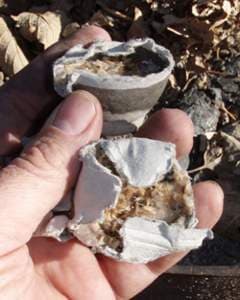
One such project, perhaps a carry over from Cub Scout days, is creating an inventory of handy fire starters that I carry with me in my kayak gear throughout the year. These candle-like wax starters are easy - and fun- to make and provide an activity for those days when cabin fever starts messin' with your head.
Egg carton fire starters are quick and easy fire starting blocks, utilizing the egg cup from a paper (not a plastic/styrofoam) egg carton with the innards formed from sawdust and candle wax. There are fire starter sticks and synthetic polymer starters out there and there are several tried and true tricks to start fires. These "eggs" are easy to make and give new life to otherwise discarded wax and shop room saw dust.
TAHE 10'6 & 11'6 SUP-YAK Inflatables
2-in-1 Kayak & Paddle Board complete packages for single or tandem use.
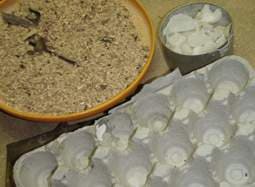
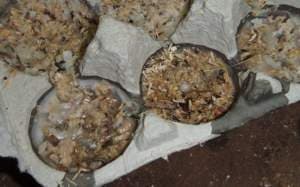
Here's how it works. A small portion of sawdust is placed into each well of a molded paper egg tray. The well is filled to the top with molten wax from bits and pieces of used candles. The sawdust is saturated with melted wax until the cup is full. It helps to "mix" the wax into the sawdust chips with a stick. It'll start to congeal as it cools but you have plenty of time to compress the wax-sawdust mix down into the cups. Gradual pouring and mixing with a stick takes about 30 seconds for each "egg".
Once the eggs are all poured, the tray is allow to set until all the eggs are firmed up - usually a few hours to become solid and cool. Once they reach that level, they can be handled without losing their shape.
You can cut or tear the individual wells from the tray. Don't worry about being too neat because any excess carton "flaps" around the upper edges of the cup can actually be used to your advantage. When it's time to ignite the egg, some other tinder can be placed on top of the well and the excess paper can be folded over to hold it in place. Otherwise the flap becomes a wick to help ignite the cups.
Basically you have created a candle with wood filler. These work just like a candle to produce a solid flame that can take the place of the first round of tinder when it comes to building a fire. Try to keep them dry, since moisture can affect the paper cup.
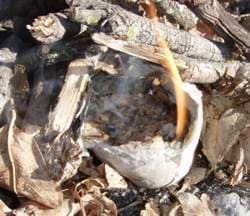
You want to make sure that the egg carton you use is made out of paper/cardboard and not the plastic/styrofoam trays that some stores sell. The plastic cartons will not hold up well (if at all) to the heat of the molten wax, and will not serve as a good wick or kindling for the starter flame.
Candle wax scraps are easy to collect if you begin a wax can in your basement or workshop. Caution must be taken to melt the wax - I create a double boiler effect by putting the wax in a smaller can that fits inside a larger coffee can. The wax can sits on a half dozen larger steel nuts so there is an air space between the two cans. You can then use your camp stove or small propane torch to melt the wax slowly. The sawdust comes from my modest workshop and occasionally from a woodworking friend. It takes about a tablespoon of melted wax and a teaspoon of sawdust for each "egg".
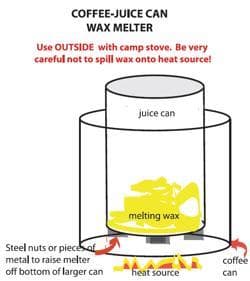
It's a simple, slightly hazardous project for the winter months. The eggs keep a long time and are very handy. They start instantly with a match, but not so quickly with a spark. When using a spark igniter, I find it very easy to put a clump of tinder (crumbled birch bark, dry grass or leaves) on top of the "egg". It becomes the wick that lights the candle. They burn quite a long time; in some cases long enough to start even slightly wet kindling.
Toss some into your emergency food/survival kit. Keep them in various spots within your gear and you will always have a handy starter. It's like having a mini, pre-made, ready-to-light campfire in your pocket. The "fire egg" can be considered tinder when lit like a candle and placed under the kindling, just as you'd do to start most fires.
Tom Watson is an avid sea kayaker with 15 years experience in the North Pacific waters of Kodiak Island, Alaska. He is also a freelance writer whose articles have appeared in most of the popular kayaking publications. He is a frequent presenter at regional kayak symposia. He is author of "How to Think Like A Survivor" (published in 2005) available on Amazon.com and most major bookstores.
Related Articles
This question is from imsealin – they asked how long should a kayak be for sea kayaking, and can it be…
One of the considerations for deciding which type of material you want your kayak to be made from…
I've been busy lately rearranging my cooking essentials: the little tools that I can't do without. Of…
A discussion on the use of a compass from a kayaking standpoint begins with basic compass savvy and then…




